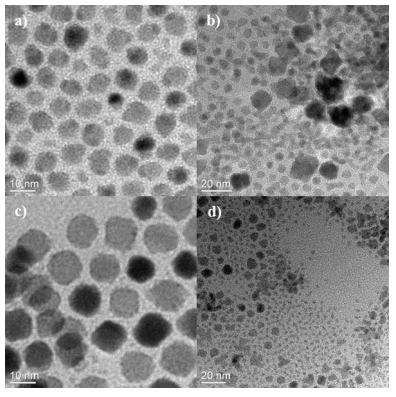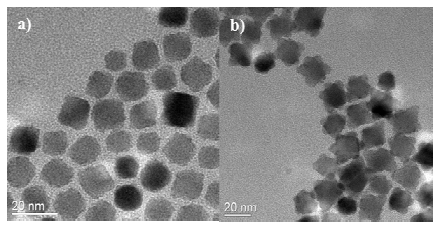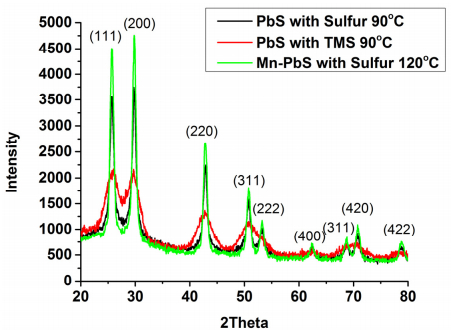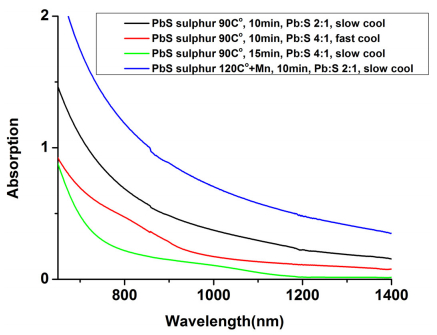PbS nanoparticles (NPs) were synthesized by the hot-injection solution-phase method using sulfur powder as precursor. Pb-precursor (446 mg PbO) was dissolved with 1.5 ml oleic acid in 15 ml 1-octadecene (ODE) solvent inside a four-neck flask under N2 atmosphere and nucleated at 120 °C for half an hour. S-precursor (S powder), dissolved in a mixture of 3 ml ODE and 1 ml Oleylamine, was then injected swiftly by a syringe into the flask with well-dissolved Pb-precursor. The growth time varied from 10 minutes to a few hours and growth temperature was maintained at from 90 to 120 °C after injection, which would result in nanoparticles of different sizes from 5 to 10 nm. The synthesized PbS NPs were characterized by TEM, XRD, and UV-Vis-NIR spectrometer. The morphology as well as absorption spectra were found to be highly sensitive to the synthesis conditions. The XRD spectra showed that the structures were less sensitive to synthesis conditions.
1.
Introduction
Consider the semilinear elliptic equation
A solution u is (linearized) stable if
The Morse index of a solution is defined to be the maximal dimension of the negative space for this quadratic form. A solution with finite Morse index is therefore not too unstable.
In 2000s, Dancer wrote a series of papers on stable and finite Morse index solutions, [13,14,15,16,17,18,19,21] (see also his survey [20] at 2010 ICM and the summary in Du [35,Section 8]). He obtained various classification results about these solutions and applied them to the study of equations with small parameters in bounded domains and global bifurcation problems. Many results on stable and finite Morse index solutions have appeared since then. We refer the reader to the monograph of Dupaigne [40] for an extensive list of results and references up to 2010.
In this paper we review some recent results about stable and finite Morse index solutions, mostly between 2010-2020. We will restrict our attention to the Liouville (-Bernstein-De Giorgi) type results on stable and finite Morse index solutions defined on the entire Rn, although there are many studies devoted to problems on bounded or unbounded domains in Rn and on complete Riemannian manifolds. As in Dancer's work, by a blow up procedure, these Liouville (-Bernstein-De Giorgi) type results should be useful in many other problems. We also refer the reader to a recent survey of Takahashi [83], which is focused on the a priori estimate aspect for stable solutions.
2.
Classification of stable solutions
In [20], Dancer proposed the following conjecture:
Assume n≤8 and u is a bounded, linearized stable solutions of (1.1).
Then either u is constant on Rn or, after a rotation of axis, u=u(xn).
If u=u(xn), the solution is called one dimensional. This is equivalent to saying that all level sets of u are hyperplanes. In the following, we say the dimension N is critical if for n<N there are only trivial (constant or one dimensional) stable solutions on Rn, while for n≥N, there exist nontrivial stable solutions. This critical dimension always exists and it is usually finite.
For nonegative nonlinearities f≥0, in a recent breakthrough work [7], Cabre et. al. obtained several a priori estimates on stable solutions, and used them to settle Brezis's conjecture on the L∞ regularity of "extremal solutions" [5]. In [41], Dupaigne and Farina used these estimates to establish the following Liouville theorem:
Theorem 2.1. Assume that f≥0 and it is locally Lipschitz. Suppose u is a stable solution of (1.1) and it is bounded below. If n≤10, then u is constant.
Hence in this case, the critical dimension is 11. This theorem can be trivially extended to nonpositive nonlinearities f≤0 (subharmonic functions) if the solution is bounded from above. But in the subharmonic case, in view of results on the singular elliptic equation
(see Esposito-Ghoussoub-Guo [42], Meadows [72], Ma-Wei [71] and Du-Guo [36]), to consider Liouville property for stable solutions, a more natural class is those solutions with a suitable polynomial growth at infinity (or even without any growth condition). In this case, it seems that the critical dimension should be 7. (In fact, (2.1) with p=1 is almost the worst case.) More precisely, we want to know if the following Liouville property holds.
Problem 1. Assume f≤0 is locally Lipschitz on (0,+∞), and it satisfies
Then there is no positive, stable solution on Rn, provided that n<7.
Here the condition (2.2) implies that there does not exist one dimensional stable solution. Note that by the above remark, no assumption on the growth of solutions is added.
If f is sign-changing but there is no one dimensional stable solution of (1.1), currently there is still not too much progress on this conjecture in dimensions n≥3.
If there exists a one dimensional stable solution of (1.1), then a double well structure is associated to this equation, that is, there exist two constants a−<a+ such that a primitive function of f, F satisfies
Here a±=limxn→±∞g(xn), where g is a one dimensional stable (equivalently, monotone) solution.
Under this assumption, Dancer's conjecture is closely related to De Giorgi conjecture (De Giorgi [28]) and stable De Giorgi conjecture about Allen-Cahn equation
By the way, based on the result of Pacard-Wei [76], in this case, the critical dimension should be 8.
Recall that De Giorgi conjecture states that
Suppose u is a solution of the Allen-Cahn equation (2.3) in Rn. If ∂xnu>0 and n≤8, then after a rotation of axis, u=u(xn).
While the stable De Giorgi conjecture states that
Suppose u is a stable solution of the Allen-Cahn equation (2.3) in Rn. If n≤7, then after a rotation of axis, u=u(xn).
In the Allen-Cahn equation, the standard double well potential (1−u2)2/4 contains only one critical point in the interval (−1,1). But in Dancer's conjecture, besides stating that if there is no one dimensional stable profile, then stable solutions must be constant, it also includes the claim when F contains more than one critical points in the interval (a−,a+). Here it is possible that a sub-double-well structure exists in (a−,a+), which makes the situation more complicate.
The De Giorgi conjecture has been solved by Ghoussoub-Gui [55] in dimension 2, by Ambrosio-Cabre [4] in dimension 3 and under an additional assumption in dimension 4≤n≤8 by Savin [78]. It was also shown to be not true in n≥9 by Del Pino-Kowalczyk-Wei [32].
By an observation of Dancer, it is known that the method introduced in Ghoussoub-Gui [55] and Ambrosio-Cabre [4] can be used to prove the stable De Giorgi conjecture in dimension 2. By the time of this writing, this is still the only proven case for stable De Giorgi conjecture. The main difficulty seems to be that, by now the only tool to tackle such problems is the Liouville property for the degenerate equation
but by Gazzola [54], there is no hope to use this in dimensions n≥3.
Even the following weaker version of the stable De Giorgi conjecture is still open.
Problem 2. Suppose u is a stable solution of the Allen-Cahn equation (2.3) in Rn, satisfying the natural energy growth bound
If 4≤n≤7, then u is one dimensional.
We say the energy growth condition (2.5) is natural because it is satisfied by minimizing solutions. (Whether this condition holds for stable solutions is another unknown point in the stable De Giorgi conjecture.) If n=3, the energy growth bound is quadratic and we can repeat the above proof of stable De Giorgi conjecture in dimension 2. This fact has been used by Chodosh-Mantoulidis in [12] to establish curvature estimates for Allen-Cahn equation on three dimensional manifolds. But as explained above, this approach does not work without such a quadratic bound. A possible way to solve Problem 2 is to establish a sheeting theorem similar to the ones for stable minimal hypersurfaces (see Schoen-Simon [80] and Wickramasekera [93]), but a geometric estimate (i.e. the oscillation estimate in [80]) is not known in this semilinear setting.
Another missing geometric estimate for semilinear elliptic equations is the one correspondent to the famous Simons inequality (Simons [82]) for minimal hypersurfaces, which is a fundamental tool in the study of stable minimal hypersurfaces (see e.g. [81], [79]). This difficulty is also encountered in the study of Bernstein property for the Alt-Caffarelli one phase free boundary problem (see Alt-Caffarelli [2]) and nonlocal minimal surfaces (see Caffarelli-Roquejoffre-Savin [8]).
Recall that the Alt-Caffarelli one phase free boundary problem is
There are some variants, such as the problem studied by Phillips [77] and Alt-Phillips [3]
as well as various approximations to these problems, e.g.
where fε is an approximate Dirac at 0 (see Fernández-Real and Ros-Oton [51]). These problems are similar to the ones considered in Problem 1, but with an integrable condition rather than the divergence condition (2.2). This integrable condition implies that there is a one dimensional monotone solution, where the solution has a non-empty dead core {u=0}, leading to a free boundary condition on ∂{u=0}.
Although most studies on these free boundary problems are focused on minimizing solutions or viscosity solutions, recently there arises some interest in higher energy critical points, see Jerison-Perera [64]. To understand these solutions, the stability condition should play an important role. Indeed, even for minimizing solutions, to prove the optimal partial regularity of free boundaries, one needs the classification of stable, homogeneous solutions just as in the Bernstein problem for minimal hypersurfaces, see Weiss [92]. For the Alt-Caffarelli one phase free boundary problem, it is conjectured that the critical dimension is 7. Currently, the Bernstein property is known to be true if n≤4 (by Caffarelli-Jerison-Kenig [10] and Jerison-Savin [65]), and not true if n≥7 (by De Silva-Jerison [29]).
In recent years, we see also much progress on De Giorgi conjecture for fractional Allen-Cahn equation
In particular, Figalli-Serra [52] solved the stable De Giorgi conjecture for the s=1/2 (half Laplacian) case in dimension 3 and the corresponding De Giorgi conjecture in dimension 4. Later their energy estimates were generalized to other fractional Laplacians by Gui-Li [56]. These estimates are optimal for s<1/2. In this case, the fractional Allen-Cahn equation is related to the nonlocal minimal surfaces. But for nonlocal minimal surfaces, it is still not known in general what is the critical dimension for the stable Bernstein property. Only some perturbative results have been obtained for those s sufficiently close to 1/2, see Caffarelli-Valdinoci [9] and Cabre-Cinti-Serra [6].
3.
Scaling invariant equations
For equations enjoying a scaling invariance, much progress has been obtained in the last decade. This is because in this case, usually there exists a monotonicity formula. As in the Bernstein problem for minimal hypersurfaces (see Fleming [53]), we can use the blowing down analysis and then the classification of homogeneous solutions to prove Liouville type results.
This approach was first undertaken by the author in [86] to study the partial regularity of stable solutions to the Lane-Emden equation (see also Davila-Dupaigne-Farina [25] for related results)
The scaling invariance for this equation says, if u is a solution of (3.1), then for any λ>0,
is also a solution of (3.1).
The optimal Liouville theorem for stable and finite Morse index solutions to this equation was established in Farina [43] by a Moser type iteration argument. The blowing down analysis can be used to give another proof. By employing Pacard's monotonicity formula ([74,75]) and Federer's dimension reduction principle ([50]), a sharp dimension estimate on the singular set of stable solutions is given in [86]. In this approach, usually we need only an estimate up to the energy level.
This approach was further developed in Davila et. al. [26] and Du-Guo-Wang [39]. In [26], a monotonicity formula is derived for the fourth order Lane-Emden equation
Then by the blowing down analysis and the classification of stable, homogeneous solutions, an optimal Liouville theorem for stable solutions of (3.2) is established. In [39], a similar result is obtained for the weighted equation
For this equation, an ε-regularity theorem is needed to analyse the convergence of blowing down sequences. See also Dancer-Du-Guo [22], Du-Guo [37,38] and Wang-Ye [84] for related results on this equation.
By now this approach has been applied to many other problems, for example, fourth order weighted equations or weighted systems [60,61], polyharmonic equations [70], nonlinear elliptic system [94], Toda system [89] and various elliptic equations involving fractional Laplacians [27,48,45,46,47,49,63].
One may be tempted to believe that this approach works well once the equation enjoys a scaling invariance. However, there are several important exceptions.
Problem 3. What is the optimal dimension for the Liouville theorem for stable solutions to the equation
This equation arises from the MEMS problem, see Esposito-Ghoussoub-Guo [42]. For some p, a monotonicity formula was given in [26], but it is not known whether there exists a monotonicity formula for all p. See Guo-Wei [59], Huang-Ye-Zhou [62], Lai [67], Lai-Ye [68] for some recent results on this problem.
We also encounter the same difficulty with the possible lack of a monotonicity formula in some other problems, which include the equation with p-Laplacians
and its fourth order version
When both u and −Δu are positive, (3.6) is equivalent to the Lane-Emden system
see Mtiri-Ye [73]. For these problems, a mysterious problem is the role of homogeneous (or radial) solutions in the classification of stable solutions. In particular, is the radial, homogenous solution mostly unstable (in a suitable sense) among all solutions?
Finally, if the blowing down analysis approach works, usually we could obtain a radial symmetry result about stable solutions when the space dimension is critical. By the moving plane method, this claim can be reduced to the classification of stable, homogeneous solutions in the critical dimension. This is similar to the classification of stable minimal hypercones in R8. For example, the following problem is still not completely solved.
Problem 4. Suppose u is a stable, homogeneous solution of (3.1) in Rn, where n is the critical dimension. Is u radially symmetric (after a translation)?
By the radial symmetry criterion of Guo [58], this is reduced to the classification of solutions w∈C2(Sn−1) to the equation
satisfying the stability condition
If n is critical, we need to show that w must be constant.
In [86], this is wrongly claimed to be true. But the proof therein works only for a small range p∈[pJL(n),pJL(n)+ε(n)). (Here pJL is the Joseph-Lundgren exponent, see [66].) The remaining case is still not known.
In Dancer-Guo-Wei [24], infinitely many solutions to (3.8) are constructed. However, it seems difficult to verify (3.9) because it involves a spectral bound condition. To the best knowledge of the author, there is still no known smooth stable (in the sense of (3.9)) solutions of (3.8) other than the constant solutions.
Problem 5. Take k,ℓ≥1 so that k+ℓ=n. Does there exist a nontrivial, stable solution of (3.1) invariant under the group SO(k)×SO(ℓ)?
4.
The structure of finite Morse index solutions
Concerning finite Morse index solutions on Rn, for nonegative nonlinearities f≥0, Dupaigne and Farina in [41], under the same assumptions of Theorem 2.1 (plus some technical conditions), proved that finite Morse index solutions to (1.1) are radially symmetric.
Next, for those scaling invariant equations discussed in Section 3, the blowing down analysis still works. So if the Liouville theorem holds for stable solutions, then it also holds for finite Morse index solutions, except in an exceptional dimension. (This is the "Sobolev" critical dimension. For example, for (3.1), it is well known that when p=(n+2)/(n−2), there exist infinitely many solutions with finite Morse index.)
In the rest of this section we review some recent results on finite Morse index solutions of Allen-Cahn equation (2.3). The author in [88], and later jointly with Wei in [90], studied the structure of finite Morse index solutions in R2. For example, the main result in [90] states that
Theorem 4.1. A finite Morse index solutions of the Allen-Cahn equation (2.3) in R2 has finitely many ends.
Here an end is a connected component of the nodal set {u=0} at infinity. But in fact more information such as the refined asymptotic behavior of u at infinity follows from the proof.
By applying a reverse version of the infinite dimensional Lyapnunov-Schimdt reduction method (see Del Pino et. al. [30], [31], [32], [33], [34]), when the interfaces in the Allen-Cahn equation are clustering, we were able to reduce the stability condition in the Allen-Cahn equation to a corresponding one for Toda system
With such a connection between Allen-Cahn equation and Toda system, various results about stable solutions of Toda system can be transferred to the Allen-Cahn equation. For example, in Wang-Wei [90,91], Farina's integral estimate in [44] and the ε-regularity theorem in Wang [85,87], both for the Liouville equation
were used to establish a curvature estimate for level sets of solutions to singularly perturbed Allen-Cahn equation. (More precisely, we need the corresponding results for Toda system (4.1), but which are direct generalizations of the results about Liouville equation, see [89].) In Gui-Wang-Wei [57], the Liouville theorem in Dancer-Farina [23] about finite Morse index solutions to (4.2) was used to establish the following result.
Theorem 4.2. Suppose u is an entire solution of the Allen-Cahn equation (2.3) in Rn+1, and it is axially symmetric (i.e. u depends only on √x21+⋯x2n and xn+1) and stable outside a cylinder {x21+⋯+x2n<R2}. If 3≤n≤9, then u=u(xn+1).
Here we do not state the n=2 case (i.e. for Allen-Cahn equation in R3), which can be viewed as the "Sobolev" critical case for Allen-Cahn equation. It was proved in [57] that in this case we have "finite Morse index implies finite ends" as in Theorem 4.1.
The "finite Morse index implies finite ends" property is expected to be true in any dimension, but by now only this axially symmetric case has been proven. Note that, although Theorem 4.2 is a result in high dimensions, the axial symmetry makes the problem essentially two dimensional. This allows us to prove the quadratic decay for curvatures of {u=0} as in [90].
In Cao-Shen-Zhu [11], it was shown that stable minimal hypersurfaces in Rn have only one end, that is, they are connected at infinity. Later in [69], Li-Wang also showed that minimal hypersurfaces with finite Morse index have finitely many ends (still in the topological sense). We want to know whether the corresponding results hold for stable or finite Morse index solutions of Allen-Cahn equation (2.3).
Problem 6. Can we prove a topological finiteness result for ends of finite Morse index solutions to Allen-Cahn equation (2.3)?
Since we only want a topological finiteness, this should hold for any dimension n. However, the one end result for stable solutions is not true for Allen-Cahn equation, at least in dimensions n≥11. In fact, the examples constructed in [1] are stable solutions of Allen-Cahn equation (2.3) in Rn, where n≥11, but they have two ends. Whether this one end result holds for n≤10 is open.
In general, our understanding of finite Morse index solutions in higher dimensions is very lacking. Anyway, we do not know too much about stable solutions in dimensions n≥3. But even assuming the stable De Giorgi conjecture, we can not deduce that "finite Morse index implies finite ends", that is,
Problem 7. Assuming the stable De Giorgi conjecture in dimensions 4≤n≤7, can we prove that finite Morse index solutions of (2.3) in these dimensions have finitely many ends?
The three dimensional case can be proved as in [90] and [57], but this approach does not work in dimensions 4≤n≤7. This is because the techniques used in [90] relies on a finiteness result for nodal domains of directional derivatives ξ⋅∇u, which in turn needs the Liouville property for the degenerate elliptic equation (2.4), and as explained before, it cannot be applied in high dimensions. (In dimension 3, as in [57], a localization around each end allows us to use this technique, so we could expect the above result.) Note that the proof of Theorem 4.2 in [57] relies crucially on the axially symmetric assumption and the idea in Dancer-Farina [23]. Here the stability condition is used only in a reductive way as in Wang-Wei [90,91]. Therefore the power of the stability condition is not fully utilized. But now it is still not clear how to use the stability condition more efficiently in high dimensions.
Acknowledgments
The author's interest in stable and finite Morse index solutions was largely intrigued by N. Dancer and Y. Du about ten years ago. They taught me a lot about stable and finite Morse index solutions when I was a postdoc at Sydney University. Several problems collected in this paper were communicated to the author during various occasions from Juan Davila, Louis Dupaigne, Zongming Guo, Xia Huang, Yong Liu, Yoshihiro Tonegawa, Juncheng Wei and Dong Ye over a long period. I am grateful to them for sharing their insights on these problems. My research has been supported by the National Natural Science Foundation of China (No. 11871381).

















 DownLoad:
DownLoad: